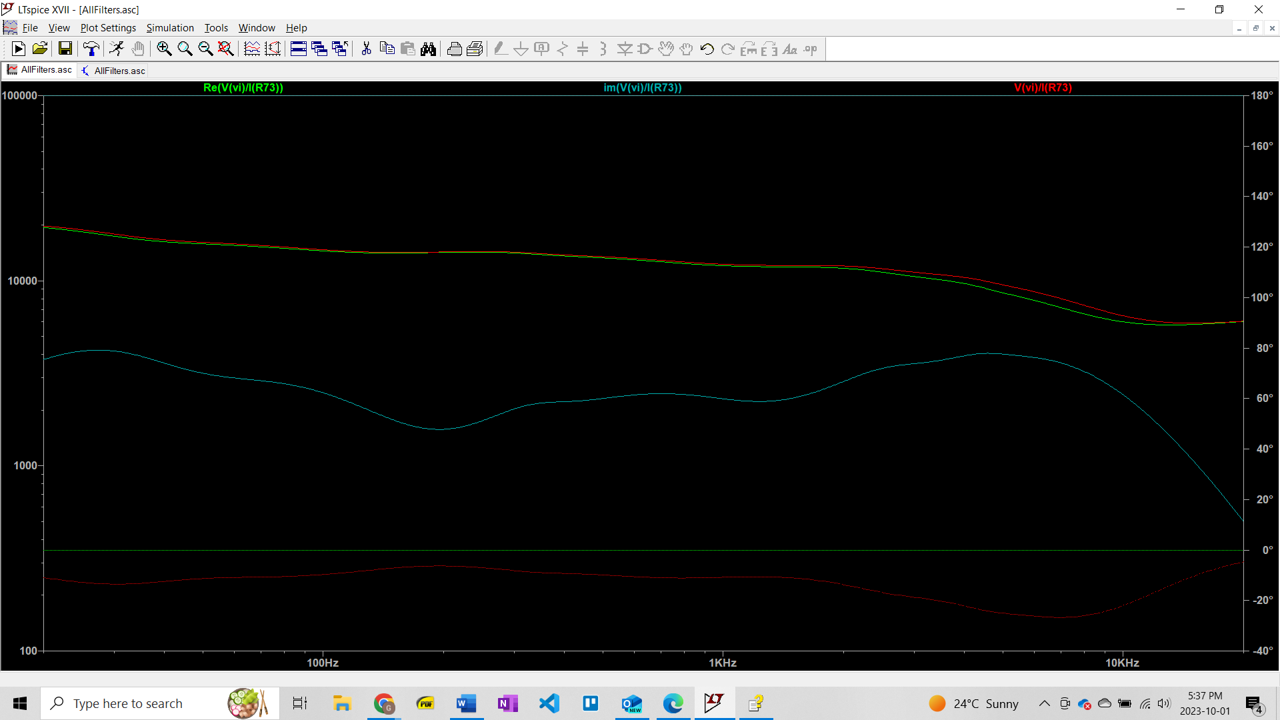- The PCB has in input resistance of [19.4kohm : 6.0kohm] and an input capacitive reactance of [4.2kohm : 499] over the audio range of 20 to 20kHZ
- At DC, the input resistance is about 21kohm
- The equivalent capacitance is [2.11uF : 6.17nF]

- No issues with drawing too much current:
- The audio jack was measured to have an output impedance of about 73 ohms << than the PCB input impedance
- In worst case scenario, over 98% of vsig will still be maintained
- Also, the headphones I have been used mere measured to have 0 ohms (resistance) headphones typically no more than 600 ohms
- The audio jack was measured to have an output impedance of about 73 ohms << than the PCB input impedance
- No issue with signal reflections
- One only needs to worry with transmission line effects if the distance the signal will propagate is comparable to the wavelength, using c = 3x10^8, the wavelength of 20khz is 15km
- Distance from audio output to furthest frequency filter = 26cm (cable) + 30cm (width of pcb) + 10cm (account not taking straightest path) = 66 cm
- Negative instantaneous power i.e. power being delivered from PCB to the audio jack to to phase shift between
- Worst case scenario, it will deliver under 100 uW to the audio jack, should be fine
- Source - ChatGPT
- In typical audio systems and applications, an audio source is not at risk of being damaged solely because it delivers a current out of phase with its voltage. In fact, phase shifts between voltage and current are quite common in audio circuits due to the presence of reactive components like capacitors and inductors in speakers and crossovers
- Audio signals fall within the human audible range, typically from 20 Hz to 20 kHz. At these frequencies, the phase shifts introduced by typical audio components are small and generally do not result in damaging conditions
- Audio sources, such as amplifiers, are designed to handle a range of loads, including those with phase shifts. They are typically equipped with protection circuits to prevent overcurrent and overheating, which are more common causes of damage
- In many audio applications, phase shifts of less than 30 degrees are often negligible. These small phase shifts usually do not noticeably affect sound quality or system behavior.
- Many audio devices incorporate protection circuits that prevent overcurrent or overvoltage conditions that could potentially damage the equipment. These circuits can handle variations in power flow due to phase shifts
- https://basicelectric.quora.com/Is-it-okay-to-connect-a-resistive-capacitive-load-to-the-audio-jack-of-a-laptop-1?__filter__=all&__nsrc__=notif_page&__sncid__=44469830214&__snid3__=59447143687
- https://www.quora.com/Is-it-okay-to-connect-a-resistive-capacitive-load-to-the-audio-jack-of-a-laptop?request_answers=1&__filter__=all&__nsrc__=notif_page&__sncid__=44472882621&__snid3__=59451464499
- https://www.reddit.com/r/audiophile/comments/16vj8px/comment/k2x0c2n/?context=3
 Ghani Lawal
Ghani Lawal
Discussions
Become a Hackaday.io Member
Create an account to leave a comment. Already have an account? Log In.